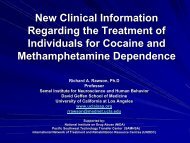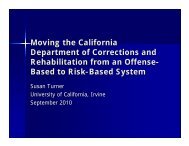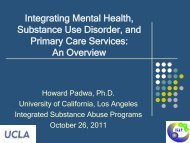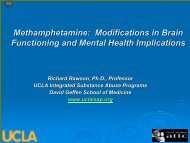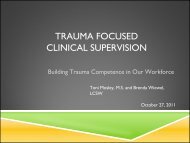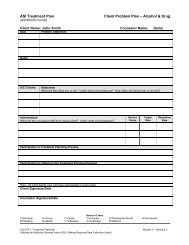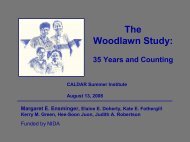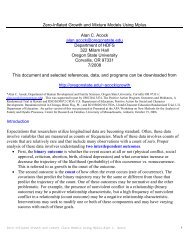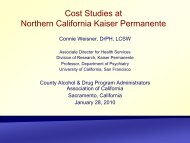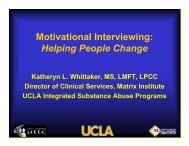The Amity In-Prison and Post-Prison Therapeutic Community (TC ...
The Amity In-Prison and Post-Prison Therapeutic Community (TC ...
The Amity In-Prison and Post-Prison Therapeutic Community (TC ...
- No tags were found...
You also want an ePaper? Increase the reach of your titles
YUMPU automatically turns print PDFs into web optimized ePapers that Google loves.
Building the First <strong>In</strong>-<strong>Prison</strong><strong>The</strong>rapeutic <strong>Community</strong> forLevel IV Custody Offenders atthe California State <strong>Prison</strong>-LosAngeles County (LAC):An Overview
Beginnings…..1n November of 1987,CDC Director JimRowl<strong>and</strong> asked <strong>Amity</strong>Chief Executive RodMullen <strong>and</strong> Deputy NayaArbiter to consult.“We’re filling up theprisons with drugoffenders,” said Rowl<strong>and</strong>,“<strong>and</strong> we are doing nothingeffective about drug abusewhile these offenders are inprison or on parole.”
Recommendations…..Mullen & Arbiter toured several prisons<strong>and</strong> parole regions, then spoke toRowl<strong>and</strong>’s Executive Staff.“Find a prison that has never had a drugprogram, <strong>and</strong> a Warden who is respectedby his peers <strong>and</strong> who will support a‘model’ program based on the therapeuticcommunity approach—which researchdemonstrates is the most effective. If themodel shows good results, it can then beexp<strong>and</strong>ed.” Mullen & Arbiter, 1987
Rowl<strong>and</strong>’s s actionsDirector Rol<strong>and</strong> began a task force on the drugproblem….this led to the formation of the Officeof Substance Abuse Programs, headed by DavidWinette.OSAP proposed developing one model programin a prison, <strong>and</strong> two parolee “networks”—one inthe San Francisco Bay Area (BASN); the otherin San Diego (P3).Rowl<strong>and</strong> then placed a call to Warden JohnRatelle…
John Ratelle <strong>and</strong> R.J. DonovanRowl<strong>and</strong> Warden Ratelle, a 30year + CDC veteran <strong>and</strong> askedhim if he would host the modelprogram.Warden Ratelle <strong>and</strong> AssociateWarden Tom Hornung visited the<strong>Amity</strong>/Pima County Jail Projectin Tucson, which provided <strong>TC</strong>treatment for 50 incarceratedsubstance abusers.“I don’t like treatment,” saidRatelle, “but I like this.”•A A request for proposal wasissued in 1990.•<strong>Amity</strong> was the successfulbidder
<strong>Amity</strong>HousingUnit<strong>Amity</strong>ProgramTrailersFacility III at R.J. Donovan,1100 Level III custody inmates
<strong>The</strong> housing unit, 200 mendouble celled...
Outcomes / Drug Use in <strong>Prison</strong>Warden Ratelle conducted twocomplete surprise tests of ALLmen in the <strong>Amity</strong> unit, no <strong>TC</strong> orcustody staff were warned: allmen locked down in their cells atthe same time <strong>and</strong> not releaseduntil all had given a urinespecimen<strong>In</strong> one test, only one man of 200was positive for drugs.<strong>In</strong> the second test, none of themen tested positive.
Outcomes / Benefits to CDC staff“ <strong>The</strong>re is a similarlypositive strikingreduction of work injury,sick leave <strong>and</strong> otherpersonal quality oflife/cost impact amongcustody assigned to thetreatment unit {<strong>Amity</strong>}versus officers in allother yards <strong>and</strong> housingunits.”David Deitch, Ph.D, Director of theAddiction Technology Transfer Centerat UCSD (1998) From a six monthstudy conducted by UCSD at the RJ.Donovan Correctional Facility betweenJanuary 1, 1997 <strong>and</strong> June 30th, 1997.)
Outcomes/Recidivism ReductionComparisons of <strong>In</strong>mateswho did NOT participateshow that 3/4ths of themwere back in prison three 75.1years after release.%But only about 1/4 of the<strong>Amity</strong> participants who Nocompleted the programTXwere in prison. 27.4%From a study conducted byH.Wexler, Ph.D. 1998NDRI funded by NIDA<strong>Amity</strong>
Outcomes / Cost benefits<strong>The</strong> 1997 Legislative Analyst’s Report on<strong>Prison</strong> Population growth determined that if the<strong>Amity</strong> results could be replicated through anexpansion of substance abuse treatment to10,000 beds over seven years, the state wouldnot have to build an additional 4,700 beds. Thatscenario would also result in a one time capitaloutlay savings of $210,000,000 with annualsavings of $80,000,000 a year.
<strong>Amity</strong> Model adopted by CDC<strong>The</strong> results of the <strong>Amity</strong>/RJD program have becomethe “template” for the expansion of therapeuticcommunity type drug treatment within CDC.<strong>In</strong> 1996 there were 400 <strong>TC</strong> beds…Currently 9,000 beds with funded aftercare havebeen authorized by the State Legislature.<strong>Amity</strong>’s <strong>TC</strong> at California State <strong>Prison</strong> at LosAngeles County, started in 1998, is the first to bringthis type of intensive <strong>TC</strong> to Level IVoffenders…………..
Breakthrough…“<strong>The</strong> <strong>Amity</strong> program at R.J. Donovan ,<strong>and</strong> the results that it has achieved, can beconsidered a breakthrough incorrections—one of those rare occasionswhen that overused term, “paradigm shift”is genuinely appropriate.”James Rowl<strong>and</strong>, Director, California Department of Corrections(retired)
Significance…..“…the Criminal Justice Treatment <strong>In</strong>itiative in theCalifornia Department of Corrections is the largestsingle state initiative in U.S. history targeting criminaldrug offenders.<strong>The</strong> growth of this initiative can be credited to theoutcomes obtained by the <strong>Amity</strong> Foundation, whichestablished the <strong>Amity</strong> <strong>Prison</strong> <strong>The</strong>rapeutic <strong>Community</strong>at the Richard J. Donovan Correctional Facility inNovember of 1990.”Robert Presley, Agency Secretary, Youth <strong>and</strong> Adult CorrectionalAgency, November, 2000
CSP-LACFive year contract awarded to <strong>Amity</strong> Foundationbeginning June, 1998.<strong>Amity</strong>’s 2 nd <strong>In</strong>-<strong>Prison</strong> <strong>TC</strong> (SAP)—now have addedCTF Soledad & CSP Ironwood (Blythe).Target Population: 200 Level IV inmates with identifiedsubstance abuse problems in their files (or volunteers).<strong>Amity</strong> participants housed on yard D, Building 3.Trailers built in the vocational area (behind workchange) for <strong>Amity</strong> program activities.
Who are the men in the <strong>Amity</strong> <strong>TC</strong>?Average age 31 yearsold-younger than othermale SAPsLength of currentincarceration 4.4 years—over twice as long as anyother SAP, <strong>and</strong> <strong>and</strong> eighttimes longer than those atCRC.52.5% African-American; 19.1% White---20% difference fromother SAPs•Data from UCLA-DARC
•A A Morning Meeting Duringone of the Quarterly “retreat”workshops
Who are the men in the <strong>Amity</strong> <strong>TC</strong>?65.5% never married---higher than that of otherSAPs63.3% not employed in the 30 days prior toincarceration—higher than other SAPsHeroin cited as the first, second, <strong>and</strong> third “drug ofchoice”---no other male SAP cites heroin as any ofthe the first three drugs of choice.16.1% identified on DSM-IV criteria as having nodrug or alcohol dependence—higher than mostSAPs
•A A Group in theTrailers
Who are the men in the <strong>Amity</strong> <strong>TC</strong>?16% report suicide attempts---higher than other SAPs14.2 years reported as age of first arrest—lower thanother SAPs21.2 lifetime arrests—higher than other SAPsNumber of felony convictions = 5.2; higher than otherSAPsNumber of years incarcerated = 10.2; much higher thanother SAPsNumber of violent felony convictions = 2; higher thanother SAPs38.9% most recent crime was a crime against a person—much higher than other SAPs (CRC programs report 3%-5%).
•Participantsarticulate theirrationalizations forengaging in criminal,anti-social behavioras part of thecurriculum.
Unique Features<strong>Amity</strong> Staff<strong>Amity</strong> CurriculumQuarterly intense retreats/workshops forparticipantsQuarterly Cross TrainingsUse of CeremonyUse of peer mentors/workersFocus on emotional safety, “sanctuary”
•<strong>The</strong> <strong>The</strong> Conclusion of oursecond retreat—Resistance, Resentment,Rationalization.
<strong>TC</strong> CurriculumAll participants are involved in ancomprehensive written curriculumdeveloped by Naya Arbiter (Extensions,LLC) specifically for <strong>Amity</strong>, <strong>and</strong>specifically for incarcerated drug abusingoffenders. Counselors are trained in thedelivery of the curriculum.<strong>The</strong> Curriculum is phased <strong>and</strong> involvesencounter groups, workshops, seminars,video playback, psychodrama, written<strong>and</strong> oral exercises, post-release planning;relationship training; emotionalintelligence <strong>and</strong> moral developmentexercises.



